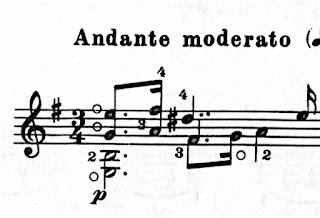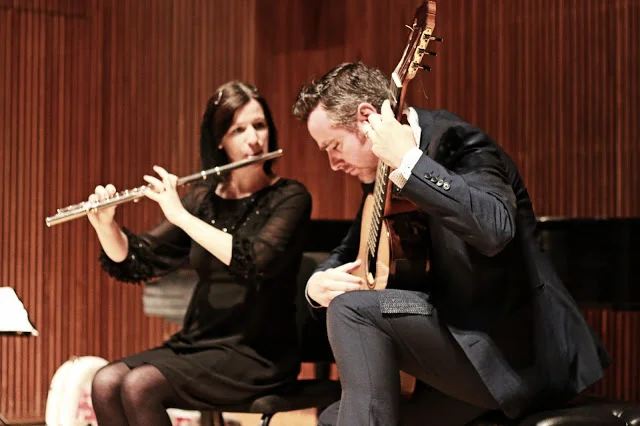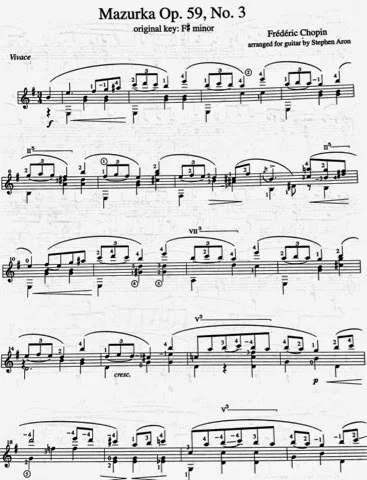Fingering for Dotted Rhythms
In my teaching I am so attentive to my student's fingerings that they sometimes get the impression that fingerings are what I care about most. This is of course not quite accurate: but without good fingerings, much of what is musically imagined, of what is intended, will fall short. A perfect example of this is easily seen in the case of dotted rhythms.
A number of years ago, when I was in the midst of a large Chopin project (I arranged and recorded the composer's entire collection of 51 Mazurkas for solo guitar), a friend made a startling comment to me after a performance. He told me that the reason my interpretations worked so well is that I played dotted rhythms correctly. Correctly!? I thought, doesn't everyone? And what's so hard about them that my handling would be distinctive in being correct? (Thanks Nicholas Goluses!)
I began taking greater notice of how others played this rhythm and was soon dismayed by what I heard. Commonly, the rhythm was insufficiently "sharp," that is, the long note wasn't long enough and the short note wasn't short enough. This is, naturally, a consideration relating to style, but it was true across style periods. More egregious though, was the realization that, in many performances of this rhythm (say, a dotted eighth followed by a 16th), there was an unwanted space between the 16 note and the note which follows it, that is, the next beat. Even the most famous artists of the day were guilty of this distortion--one you'd not hear from a pianist.
It was clearly an unresolved technical problem leading to a musical problem. It was, in fact, a fingering flaw leading to a musical interpretation flaw. I understood that, in the case of dotted rhythms, the fingering was critical; that it was not really a matter of preference but was actually a matter of right and wrong. And lots of players, and most students without guidance, did it wrong.
The fix is extremely simple and abundantly obvious, once given any consideration: always finger the short note so that the note which follows is easy to reach. That's it.
Unfortunately, we are often victims of a universal notational convention, in which the beaming of note grouping is done to clarify beats, not musical gestures. Therefore, while a series of dotted eighth-sixteenth note groups in 4/4 is sensibly beamed in four groups of two notes each, visually describing each beat by their beaming, we feel the short note as connected to the long note which follows it, a sense of gesture belied by the notation. In other words, our eyes trick us into misunderstanding the musical sense of the gesture, leading to bad fingering decisions, which then lead in turn to rhythm problems in performance.
Simply recalling the ease of falling into this trap will enable sensible solutions to be found which are both comfortable and musical.
Another contributor to this problem is also related to the visual stimulus of the score. The dotted note itself, while appearing to need to ring it's full value until the short note is articulated, is in reality often cut a little short in performance. When the long note is cut short, a brief silence is introduced before the quick note, resulting in an emphasis of the rhythmic character of the gesture and, happily for the player, enabling the repositioning of the left hand more easily for the following two notes. Inexperienced players too often struggle to let the longer note ring its full value instead of releasing it as musical context normally permits. I'll follow with a series of examples, first fingered badly, then fingered correctly.
This first example is measure 25 of Giuliani's Study Op. 1, No. 11. In the first example, the suggested fingerings do not facilitate an easy, quick execution of the quick notes. Note that from the first to the second note the second finger has to jump from the first to second string. This type of movement is to be avoided when playing quickly, as it tends to clip the first note and cause physical tension. The next gesture, from beat 3-4, will work as fingered, but it features more movement than necessary, requiring a shift on the fast note. The final gesture, from beat 4-1, is fine as fingered, but, to avoid the slight downward shift, requires a large hand. (I refer to a "large hand" when it is simply one finger-per-fret in the lower positions. We can do this easily enough of course, but the hand is more relaxed when it is the size of three frets, not four). My fingering which follows solves all three problems.


Admittedly, the difference you'll experience in each of these three spots is slight. You may prefer not to invert fingers 3 and 4 as I've suggested on both of the b-d diads, a common shape but uncomfortable for some. But the advantages conferred, when combined, are considerable. The difference in performance between
smooth and tense is often precisely this type of small, subtle difference. In the improved version, the hand moves less, better facilitating a more precise reading of the rhythm.
(Please feel encouraged to comment on these thoughts, either here on my blog or in response to my Facebook announcement thread. Also, it is not my intention here to disparage the work of other editors, but rather to try and elucidate differing points of view where fingering and interpretation are concerned).
Next are a few examples from Rodrigo's masterful Sonata Giocosa. The second movement, Andante moderato, is based on the dotted eighth-sixteenth note rhythm in question. Note the following passage and the recommended fingerings:

The 3rd and 4th fingers are both expected to "hop" from their position on f# and a down to d# and f#. This hopping motion creates a loss of legato and makes a true rendering of the rhythm very difficult. Here is the simple adjustment that makes it work perfectly:

It is true that, in placing the half-barre, the low b must be abandoned, but the net result is still more musically satisfying and has the advantage of allowing a correct interpretation of the rhythm with much less effort. (As an alternate approach which does permit the low b to ring, try using 1 to play the low b, then drop the finger into a full barre while still holding it--a type of hinge barre).
Consider this passage:

Note the awkward movement from the last note in the first bar, g, to the chord on the following downbeat. The 2nd finger is expected to leap to the 5th string after playing the short 16th note on the 1st string. A lyrical, legato, rhythmically precise execution is impossible. The fix is simple:

By placing the barre in advance, the gesture is nearly guaranteed to come out correctly. And the abandonment of the middle-voice c is not noticed, as the musical gesture is now correct.
Here is another example from the same piece:

In this eight-bar excerpt, there are seven fingering corrections that are required to enable a consistent reading of the dotted rhythm. In each case, the original treats the notes inside a beat as musically connected, when in fact, the sixteenth note at the end of each beat is musically connected to the notes which follow. The first change is a reiteration of the example above; the second, in the third bar, again replaces a finger-hop with a smoother move by using 4 as a guide finger and freeing the 3rd finger for the 3rd string. Next, in the 3rd bar, a half-barre is placed and a finger substitution combine to create a smoother reading. The remaining adjustments similarly achieve the end of allowing the short notes to move effortlessly and quickly to the long notes.

If we take care to finger such moments in our scores correctly, accommodating, first and foremost, the musical gesture in question and resist being fooled by the appearance of the notation, we'll normally get better results. Listen for bumps in the rhythm as you play, and be alert for moments in the score that feel awkward. Look more closely at your fingering and consider alternatives. And, in the case of dotted rhythms, consider the simple advice offered here.






